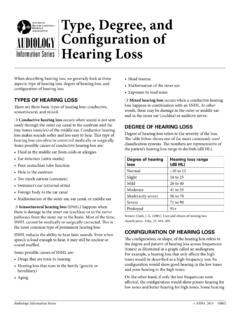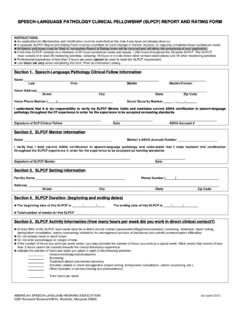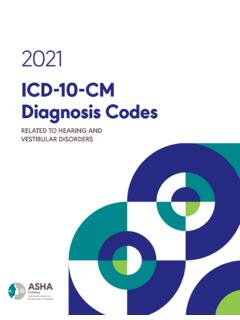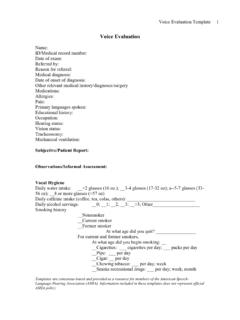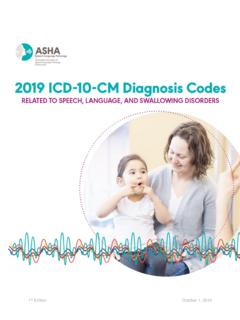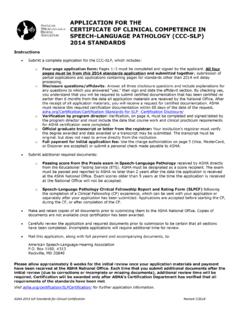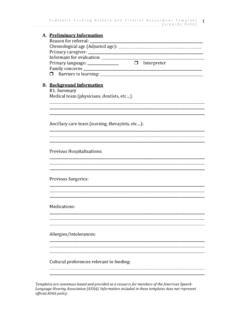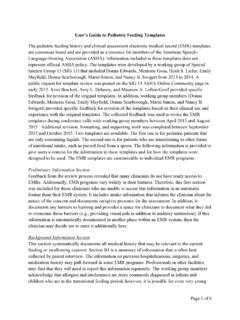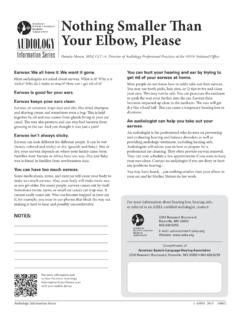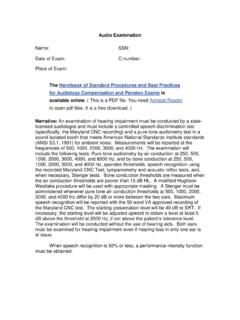Transcription of Type, Degree, and Configuration of Hearing Loss
1 Type, Degree, and AUDIOLOGY Configuration of Information Series Hearing loss When describing Hearing loss , we generally look at three Head trauma aspects: type of Hearing loss , degree of Hearing loss , and Malformation of the inner ear Configuration of Hearing loss . Exposure to loud noise TYPES OF Hearing loss m Mixed Hearing loss occurs when a conductive Hearing There are three basic types of Hearing loss : conductive, loss happens in combination with an SNHL. In other sensorineural, and mixed. words, there may be damage in the outer or middle ear and in the inner ear (cochlea) or auditory nerve. m Conductive Hearing loss occurs when sound is not sent easily through the outer ear canal to the eardrum and the DEGREE OF Hearing loss .
2 Tiny bones (ossicles) of the middle ear. Conductive Hearing loss makes sounds softer and less easy to hear. This type of Degree of Hearing loss refers to the severity of the loss . Hearing loss can often be corrected medically or surgically. The table below shows one of the more commonly used Some possible causes of conductive Hearing loss are: classification systems. The numbers are representative of the patient's Hearing loss range in decibels (dB HL). Fluid in the middle ear from colds or allergies Ear infection (otitis media) Degree of Hearing Hearing loss range Poor eustachian tube function loss (dB HL). Hole in the eardrum Normal 10 to 15.
3 Too much earwax (cerumen) Slight 16 to 25. Swimmer's ear (external otitis) Mild 26 to 40. Moderate 41 to 55. Foreign body in the ear canal Moderately severe 56 to 70. Malformation of the outer ear, ear canal, or middle ear Severe 71 to 90. m Sensorineural Hearing loss (SNHL) happens when Profound 91+. there is damage to the inner ear (cochlea) or to the nerve pathways from the inner ear to the brain. Most of the time, Source: Clark, J. G. (1981). Uses and abuses of Hearing loss SNHL cannot be medically or surgically corrected. This is classification. Asha, 23, 493 500. the most common type of permanent Hearing loss . SNHL reduces the ability to hear faint sounds.
4 Even when Configuration OF Hearing loss . speech is loud enough to hear, it may still be unclear or The Configuration , or shape, of the Hearing loss refers to sound muffled. the degree and pattern of Hearing loss across frequencies (tones) as illustrated in a graph called an audiogram. Some possible causes of SNHL are: For example, a Hearing loss that only affects the high Drugs that are toxic to Hearing tones would be described as a high-frequency loss . Its Hearing loss that runs in the family (genetic or Configuration would show good Hearing in the low tones hereditary) and poor Hearing in the high tones. Aging On the other hand, if only the low frequencies were affected, the Configuration would show poorer Hearing for low tones and better Hearing for high tones.
5 Some Hearing Audiology Information Series ASHA 2015 10802. loss configurations are flat, indicating the same amount of o Illnesses or infections such as CMV, Rubella Hearing loss for low and high tones. o Head injury Other descriptors associated with Hearing o Exposure to loud noise loss are: o Traumatic brain injury (TBI). Bilateral versus unilateral. Bilateral Hearing loss means Symmetrical versus asymmetrical. Symmetrical means Hearing loss in both ears. Unilateral Hearing loss (UHL) the degree and Configuration of Hearing loss are the means that Hearing is normal in one ear but there is same in each ear. Asymmetrical means the degree and Hearing loss in the other ear.
6 The Hearing loss can range Configuration are different in each ear. from mild to very severe. UHL can occur in both adults Progressive versus sudden Hearing loss . Progressive and children. means that Hearing loss becomes worse over time. Approximately 1 out of every 10,000 children is born Sudden means that the loss happens quickly. Such a with UHL, and nearly 3% of school-age children have Hearing loss requires immediate medical attention to UHL. Children with UHL are at higher risk for having determine its cause and treatment. academic, speech-language, and social-emotional Fluctuating versus stable Hearing loss . Fluctuating difficulties than their normal Hearing peers.
7 This may means Hearing loss that changes over time sometimes be because UHL is often not identified, and the children getting better, sometimes getting worse. Stable Hearing do not receive intervention. loss does not change over time and remains the same. Below are some possible causes of UHL: o Hearing loss that runs in the family (genetic or hereditary). o An outer, middle, or inner ear abnormality o Syndromes such as Down and Usher syndrome NOTES: For more information about Hearing loss , Hearing aids, or referral to an ASHA-certified audiologist, contact: 2200 Research Boulevard Rockville, MD 20850. 800-638-8255. E-mail: Website: Compliments of American Speech-Language- Hearing Association 2200 Research Boulevard, Rockville, MD 20850 800-638-8255.
8 For more information and to view the entire Audiology Information Series library, scan with your mobile device. Audiology Information Series ASHA 2015 10802.
